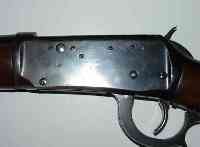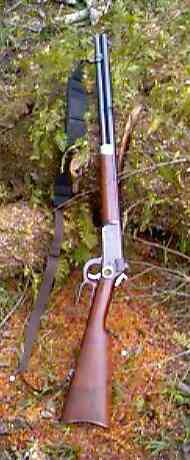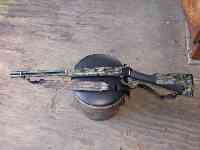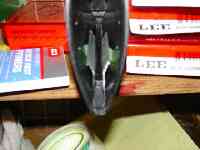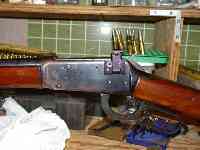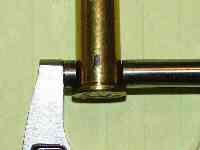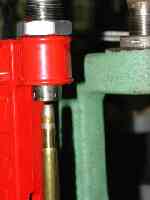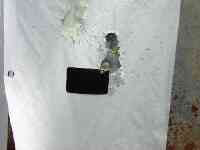195 gr Cast Bullets in a Lever Action 30-30
Click thumbnails for full size pop-up photos.
|
The used gun section of the local pawn and gun shop is one of my favorite places. You never know what some fool will pawn and not redeem. On a recent visit, there on the wall rack leaned an old Winchester Model 94. I like older Winchester lever actions. The ones without the Politically Correct safety. The ones with the two factory drilled and tapped holes for peep sights, the sights God meant for us to use on lever actions. A glance at the price tag hanging from the lever showed:
The stock and forearm were scratched, but not terribly so. The action and the tangs were almost covered with a rusty brown hue, like an old muzzleloader. The barrel surface had a little rust, but not much. Worst thing on the barrel was the spot where a gunsmith's vice had deeply scratched it below the front sight—the sight he installed with a sledge hammer from the looks of the dents in it. Knowing the rifle's bore surely looked as bad as the rest of the rifle, I pulled it off the rack anyway. Immediately, I noticed its light weight compared to the weight of my Model 94 at home, a well-maintained Buffalo Bill Commemorative which weighed 7 lbs 5 oz. A quick look down the muzzle of this 6 lbs or so rusty relic showed good rifling. I had pulled older Model 94s from that same rack, and the rifling just below their crowns looked like a smoothbore shotgun because of cleaning rod wear.
At home, I started thinking. I was at the beginning of a multi-month recovery period from two heart surgeries and emergency abdominal surgery, all within six days. Following that Death's Door experience and three weeks in a hospital, some of it in agony, my thoughts had turned to dreams of extended periods of tent camping with my days spent roaming deep woods in search of deer and wild hogs and my nights spent around a campfire. Oh, for the moon at night and glowing embers rising into the blackness! Oh, for the call of owls and coyotes and the tinkle tinkle tinkle of ice in a sniffer of brandy!
The ugly, but lightweight—and cheap—Model 94 in the pawnshop started looking better. It was time to take a closer look at the bore. A good bore mattered. Who cares about rust and dings on a woods rifle? I returned to the pawnshop and carried with me a little fold-up 10x magnifying glass, the kind used by jewelers, geologists and secondhand lever action shoppers. In sunlight and through my little magnifying glass, the rifling at and below the rifle's crown looked fine. Actually, it looked better than fine. It looked new. I had the pawn shop owner run a cleaning patch soaked with solvent through the bore. It came out green with copper fouling. After a few more swipes, he ran an oiled patch back and forth through the bore, then a dry patch. I borrowed his borelight, stuck the lighted end in the chamber, and looked down the muzzle again. The rifling, including at the crown, looked as sharp as the day the rifle left the Winchester factory in the year of God-knows-when. It was un-friggin'-believable, especially considering the way the outside looked. At $159.95, the rifle was priced right. "What's your lowest price?" I asked the owner anyway. He knew he had me when I walked in the door and headed to the wall rack and picked up the rifle again. "$150," he answered. "Where'd you get it? Hell, I come in here all the time, and I ain't seen it." "Fellow kept it on hock and finally didn't pick it up. It's been in the back for a year." "You guarantee it'll fire ok and load and eject ok?" "Yep," he said. "Sold," I said. I took it home and test fired several rounds. It worked like a charm.
I decided to make it as lightweight as possible. That meant selecting the lightest available sling and attachments and installing a Ram-Line plastic stock and forearm. As a must, I would replace the factory sights with a Williams Firesight front sight and a Williams peep rear sight containing a .150" diameter non-"Twilight" aperture. I assumed the aluminum Williams sights would weigh less than the factory iron sights. Wrong. I assumed the nylon Ram-Line stock and forearm would weigh less than the factory wood stock and forearm. Partially wrong. Here's a table listing the items I bought in order to build a "Heart Attack Rifle":
Ram-Line offers their Model 94 stock in S.W.A.T. team black only. The Model 94 is a woods rifle, not an urban warfare rifle. They would sell many more Model 94 camo stocks than black stocks. In fact, if they decide to start selling them I'm replacing the one on this rifle.
The swivel stud's instructions called for a 5/32" bit. But with that size pilot hole, installing the swivel stud cracked the plastic brace and popped loose one end of an aluminum strip. After saying $#@%^ or something similar, I re-drilled the hole with a larger, 3/16" bit. Then, using a toothpick, I put epoxy in the hole. I then re-installed the stud and smeared a big dollop of epoxy around the aluminum strip. The stud isn't coming out. By the way: if someone would make a hinged buttplate for Ram-Line stocks, there's all kinds of hidden storage space inside the hollow stock.
There's two things I want the reader to notice about this photo:
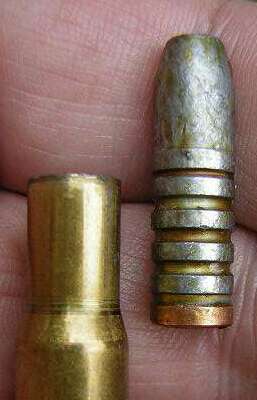 As the photo on the right shows, with the RCBS 180 FP bullet seated to the crimping groove, only the gas check protrudes below the case neck.
As the photo on the right shows, with the RCBS 180 FP bullet seated to the crimping groove, only the gas check protrudes below the case neck.In 1986, using H4895 and the 195 gr bullet, I achieved 1800 fps muzzle velocity and 100 yard groups of around 4" from Ol' Bill. With today's Varget in the heart attack rifle, 2000 fps seemed possible. Groups of around 2" at 50 yards would be fine from a woods rifle. Since there's no published data for a 195 gr cast bullet with Varget for a Model 94 30-30 (and Hodgdon didn't answer an email query for data), I decided to deduce a load from the Fouling Shot data for other calibers. I would begin with 28.0 grs of Varget. I started at 28.0 grs of Varget for two reasons: (1) it was less than the average weight of Varget used by the CBA target shooters, and so was the weight of my 195 gr bullet; and (2) Hodgdon lists a maximum of 33.0 grs Varget with a 170 gr jacketed bullet, so 28.0 grs seemed reasonable for a 195 gr cast bullet. First, the other load data:
With a micrometer, I then measured the before and after firing diameters of the cases. As shown in the photo, I orientated the black dots up when measuring. I also placed the micrometer's jaws in the exact same position for each measurement. The Remington 170 gr factory rounds averaged a case head increase in diameter of .00395". So my goal then became 1950 to 2000 fps muzzle velocity with the 195 gr bullet and with less than .00395" case head expansion—with decent accuracy, of course. My starting load of 28.0 grs of Varget gave 1903 fps average muzzle velocity and an average case head expansion of .0018". I'm sure I had a big smile on my face because my goal of 1950 to 2000 fps at moderate pressure was obviously reachable. I increased the load in .1 gr increments. At 28.4 grs Varget, velocity averaged 1973 fps and case head expansion averaged .00311". And there I stopped. Pressures were several thousand psi less than factory loads, and, as a bonus, my Lee 2.1cc dipper threw almost that exact weight of Varget. It don't get no better than that. . . . Here's two interesting facts about my Varget load of 28.4 grs:
Average Velocity 6 feet from the muzzle = 1973 fps
Note the shiny case neck showing evidence of where my Forster outside neck turner did its job. I adjust the cutter depth so that it turns an area of about 60 % of an average case neck. This photo shows a neck's turned side. In all my years of turning case necks, I've never met a case neck the same thickness all the way around.
Here's a 3 shot, 50 yard group with 1 3/8" vertical spread and 3/8" horizontal spread. The group is about 1" high at 50 yards. It also shows better accuracy from the rifle than I had hoped. I tweaked the point of impact a little to the left and called the rifle zeroed. Below, see the ballistic data:
My woods rifle/heart attack rifle is a sure killer out to 150 yards. However, I doubt I ever shoot game at that distance. I averaged the distance of shots at the deer I killed and the ones I missed, and the average is 66 yards. Most were 30 yards or so. The longest was 140 yards, a kill. The closest was 20 yards . . . a miss.
The bullet lube sealed the necks. I used a daub of red fingernail polish on the case heads. The fingernail polish oozes around the primers, sealing them nicely. It also oozes into the stamped letters on the case heads and marks the 30-30 rounds as belonging to the heart attack rifle and not to Ol' Bill. If I drop the woods/heart attack rifle in a creek or get caught in a downpour, the rounds will shoot after I sling the water out of the rifle. Don't do as I did in this photo. I daubed polish on all the heads so the photo would look cool. It dried. I had hell removing it from those case heads. Daub a case head, then wipe it while the polish is still wet. This heart attack/woods rifle project taught me one thing for sure: beauty truly is only skin deep. With a little work, money, and research, a pawn shop's ugly duckling became a thing of beauty perfectly suited for its new function—a lightweight, hard-hitting, lever action cast bullet rifle with moderate recoil.
| |||||||||||||||||||||||||||||||||||||||||||||||||||||||||||||||||||||||||||||||||||||
